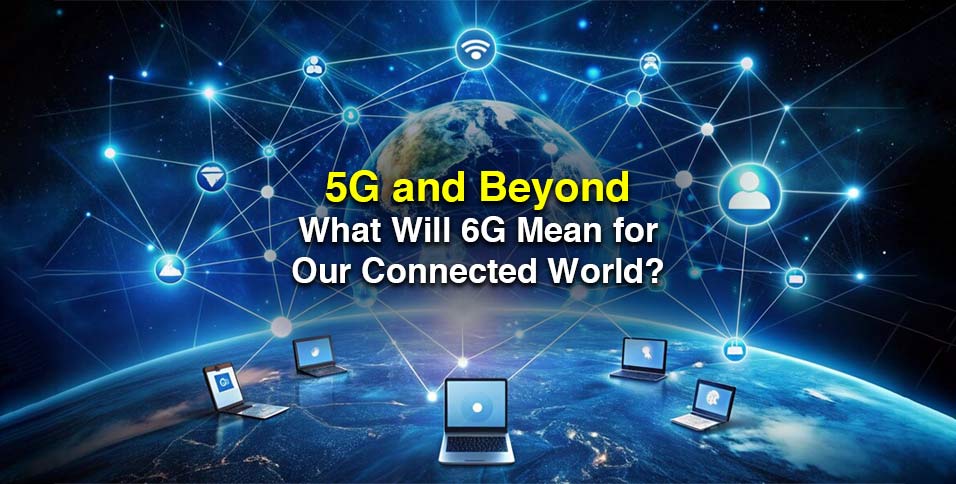The rapid rollout of 5G technology is already transforming industries and changing how we connect with the world. But as with any technological leap, the next phase is always on the horizon. 6G is being touted as the future of connectivity, promising speeds and capabilities that go far beyond what 5G currently offers. While 5G is still in its early stages, discussions about the development and impact of 6G are well underway, and its potential could revolutionize the digital landscape in even more profound ways.
What is 6G?
6G represents the sixth generation of mobile networks, which is expected to build upon and improve the infrastructure laid by 5G. While 5G is focused on providing ultra-fast data speeds and low latency, 6G is expected to deliver even higher data rates—potentially up to 100 times faster than 5G. This would enable unprecedented levels of connectivity, making technologies like real-time holographic communications and advanced AI-driven applications a reality.
Key Features of 6G
Higher Speeds and Lower Latency
One of the most anticipated features of 6G is its blazing speed. With data transfer rates potentially reaching up to 1 terabit per second, 6G would allow for instant downloads and data processing in ways that are currently unimaginable. The latency of 6G networks is expected to be nearly zero, making real-time applications far more efficient.
This ultra-low latency will be particularly crucial for industries that rely on precision and speed, such as healthcare (think remote surgeries), autonomous driving, and real-time gaming experiences.
Artificial Intelligence Integration
Unlike previous network generations, 6G will heavily integrate artificial intelligence (AI) to optimize and manage networks. AI will play a central role in enhancing network efficiency, data management, and ensuring seamless connectivity. With AI becoming an integral part of 6G, the network will be able to make real-time decisions, anticipate user needs, and dynamically allocate resources for better performance.
Expanding the Internet of Everything (IoE)
6G is expected to facilitate the Internet of Everything (IoE), where not just devices but entire systems—such as transportation grids, factories, and even cities—are interconnected. The level of data sharing and communication between devices will become more advanced, making automation smarter and more efficient. The IoE will expand on the Internet of Things (IoT), connecting millions of devices to support intelligent infrastructure and smart cities.
The Impact of 6G on Different Industries
Healthcare and Telemedicine
With near-instant data transmission, 6G will revolutionize healthcare by enabling real-time telemedicine, including remote surgeries and AI-driven diagnostics. The possibilities for improved patient care and faster response times will grow as 6G becomes a central part of medical infrastructures.
Entertainment and Gaming
The entertainment and gaming industries are already benefiting from the capabilities of 5G, but 6G will take things even further. For instance, virtual and augmented reality experiences will become more immersive, with 6G providing the bandwidth and low latency required for seamless interactions. Online platforms, such as streaming services and even gaming sites like a casino online in NZ, will be able to offer enhanced experiences with richer graphics, faster responses, and even live interactive elements in real-time.
Autonomous Systems
Autonomous vehicles, drones, and robots are heavily reliant on connectivity for real-time data exchange and decision-making. 6G’s super-fast speeds and low latency will make these systems much more efficient, safer, and capable of handling complex tasks with minimal human intervention.
Challenges in Implementing 6G
While 6G offers exciting prospects, there are significant challenges to its implementation. Developing the infrastructure needed to support such high speeds and bandwidth will require significant investment and collaboration between governments, businesses, and tech companies. Additionally, there are questions about energy consumption, as faster data speeds typically require more power. Finding sustainable ways to power 6G networks will be critical to its success.
Moreover, regulatory frameworks will need to evolve to accommodate 6G technologies, particularly in sectors like data privacy and cybersecurity, which will become even more essential as 6G integrates into every aspect of life.
When Can We Expect 6G?
While 5G is still in its infancy, 6G development is already underway, with predictions that the technology will start rolling out commercially around 2030. Various research initiatives across the globe, including efforts in countries like the United States, China, and South Korea, are working towards defining the technical standards for 6G.
Conclusion
As we look ahead to 6G, the future of connectivity is poised to become faster, smarter, and more integrated than ever before. From healthcare and autonomous systems to gaming and entertainment, 6G will revolutionize the way we live, work, and play. However, while the promises are exciting, the challenges of implementation, regulation, and sustainability need to be addressed to ensure that 6G can truly transform our connected world.
For businesses and individuals, preparing for the rise of 6G will involve not only embracing new technology but also adapting to the changes it brings in industries across the board.
Also Read: LG sets a new distance record for 6G transmission















